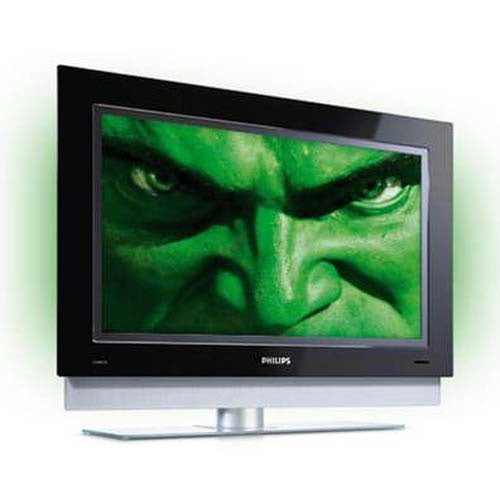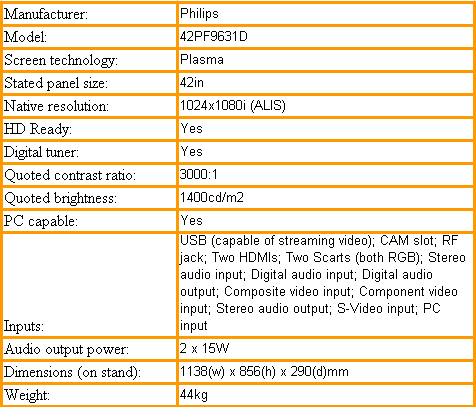Philips 42PF9631D 42in Plasma TV Review
Philips 42PF9631D 42in Plasma TV
Does Philips make better LCD or Plasma TVs? John Archer attempts to find out.

Verdict
Key Specifications
- Review Price: £1456.50
In case you hadn’t noticed, HD DVD vs Blu-ray is not the only vicious format war currently raging within the AV industry. For also currently tearing chunks out of each other are LCD and plasma flat TV technologies. In fact, this screen war has just been kicked up a gear by Hitachi, Pioneer and Panasonic, who’ve actually joined forces to remind the public of the supposed strengths of plasma over LCD technology via a barrage of in-store materials and an in-depth, pull-no-punches website: www.plasma-lcd-facts.eu.
While a good format war always gives us hacks plenty to write about, it’s always a relief to find a few brands that prefer to stay neutral by supporting both camps. And one of the most high profile of these neutral players is Philips. In fact, Philips’ refusal to choose one flat TV option over the other even extends to the most heavily contested size of the flat TV market: 42in. So while we’ve already tested a Philips 42in LCD TV, the 42PF5421, we now also find ourselves faced with a 42in Philips plasma TV in the form of the 42PF9631D.

The $64,000 question, of course, is whether Philips’ egalitarian gesture of allowing Joe Public to decide which format of 42in TV he wants is really worthwhile, or whether the brand does one technology so much better than the other that it really might as well stick with what it does best…
The 42PF9631D is certainly no half-hearted effort aesthetically. The deep, glossy black screen frame is really eye-catching, and provides the perfect counterpoint to the set’s most in-your-face feature: Ambilight.
If you’re not familiar with this, it comprises fluorescent tubes down each side of the TV that can emit pools of light that automatically change colour in sympathy with the main colour components of the picture at any given time. This sounds horrendously gimmicky, we’ll grant you; but honestly, as well as looking cooler than you might think, it also genuinely makes long-term viewing more relaxing by broadening the area of brightness that your eyes are focussed on.
Another key – if more controversial – feature of the 42PF9631D is hinted at by a curious claimed native resolution of 1,024 x 1,080i. On the one hand this resolution looks pretty exciting with its ‘full HD’ 1080 line count. But then it also looks rather puzzling with its mere 1024 vertical rows when a proper full HD picture would have 1,920. In fact, you’d be forgiven for thinking that this TV is nearly square rather than widescreen (though it isn’t, of course).
The reason for this resolution curio is something called Alternate Lighting of Surfaces – or ALIS for short. As briefly as possible, ALIS combines an expanded phosphor area with electrodes that light the area between the pixels as well as the pixels themselves to deliver a perceived interlaced resolution of 1080 lines, even though the actual pixel count is only half that.

Admittedly this sounds a bit dodgy when you strip it down as far as we just did – and there’s no getting round the fact that since the vertical rows only number 1,024 rather than 1,920, HD pictures are still going to have to be processed and resized more than they would be for a true 1,920 x 1,080 TV. But the system is deemed good enough by the industry to earn the 42PF9631D its HD Ready wings.
Another initially confusing feature discovery is Pixel Plus 2 HD image processing when other Philips TVs now use Pixel Plus 3 HD. But actually this merely marks the 42PF9631D out as a mid-range set, since it has become common practice for Philips to use different generations of Pixel Plus as a means of differentiating sets across its massive flat TV range. That’s not to say, though, that we won’t still feel the loss of the new noise reduction systems Pixel Plus 3 HD brings to the table.
Other features worth a quick mention include a built-in digital tuner with all the CAM slot and electronic programme guide trimmings; two HDMIs; PC connectivity; and USB ports for direct playback of JPEG or video file formats stored on USB devices.
And so to the moment of truth: does the 42PF9631D’s plasma picture hold up against its same-sized LCD counterpart? And the answer is… just barely.
Kicking off with the good stuff, colours immediately strike us as unusually radiant by plasma standards. The effervescent tones of an animated film like Monsters Inc. look simply dazzling, as do many HD games on our Xbox 360. But even fairly mundane TV and movie footage gains lustre from the 42PF9631D’s apparent mission to be noticed on a shop floor among all the bright young LCD things.
Of course, such colour vibrancy wouldn’t be much use if the tones underlying it weren’t natural. But for the most part they are, as the set even passes with flying colours – pun intentional – such a trickily toned sequence as the Mines of Moria segment of The Fellowship of the Ring.

Pixel Plus 2 HD, meanwhile, works its customary wonders on the picture’s apparent sharpness. The 42PF9631D therefore does full justice to the extra fine detail in a high definition picture as well as making standard definition sources look much crisper than they would normally.
The 42PF9631D also does well at avoiding motion noise, be it either smearing caused by the demands motion places on the Pixel Plus 2 HD engine, or fizzing noise caused by the core reaction speed of the plasma panel.
So why did we say pictures barely hold up versus Philips’ same-sized LCD model? First, black levels aren’t great by today’s plasma standards, with dark scenes flattening out into grey earlier than they should. Also, where there should be smooth colour blends we sometimes found the Philips unable to resolve the colour shifts subtly enough, resulting in a quite distracting striping effect. And finally, without Pixel Plus 3 HD’s new noise reduction elements, Pixel Plus 2 HD can make standard definition pictures look a tad noisy.
The 42PF9631D’s sound is more consistent. Sure, more mid-range openness wouldn’t have gone amiss, but the soundstage is still large and powerful enough to engage, even during a fairly raucous action scene.
”’Verdict”’
Comparing this Philips plasma set with the brand’s similarly sized LCD TVs, we’d probably be inclined to go for the LCDs. However, that’s certainly not meant to imply that you should always choose LCD over plasma, for there are a number of plasma alternatives out there able to give LCD a much, much better run for its money than this Philips effort can.

How we test televisions
We test every TV we review thoroughly over an extended period of time. We use industry standard tests to compare features properly. We’ll always tell you what we find. We never, ever, accept money to review a product.
Trusted Score
Score in detail
-
Value 7
-
Image Quality 7
-
Sound Quality 8

